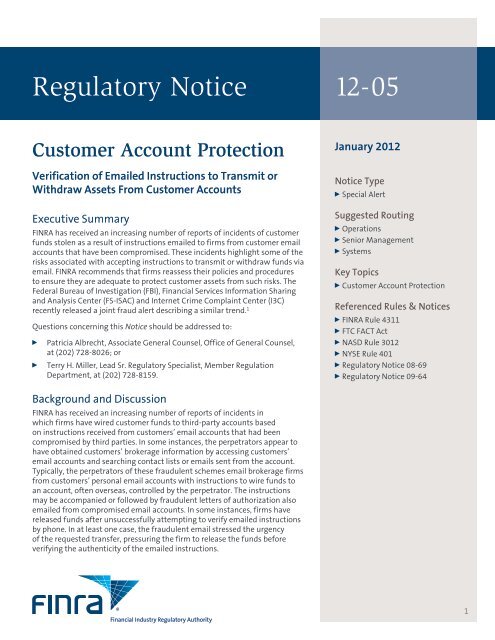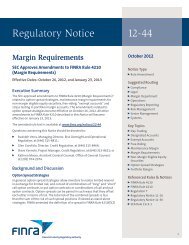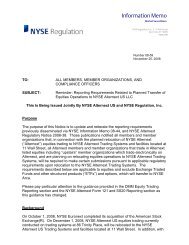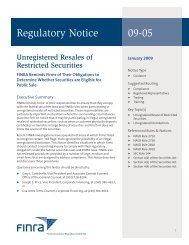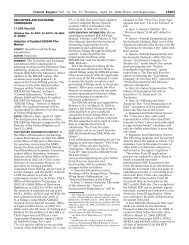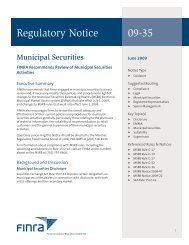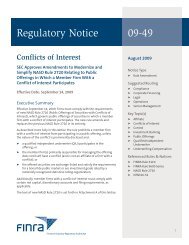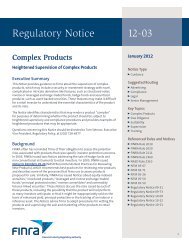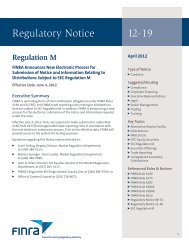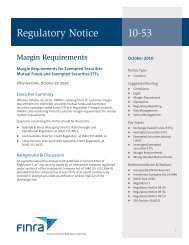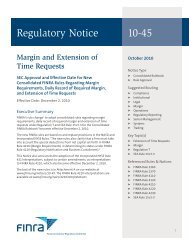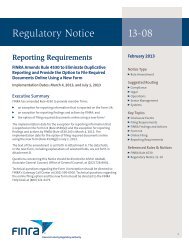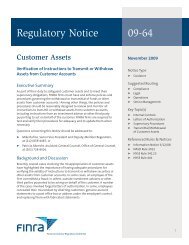Regulatory Notice 12-05 - finra
Regulatory Notice 12-05 - finra
Regulatory Notice 12-05 - finra
You also want an ePaper? Increase the reach of your titles
YUMPU automatically turns print PDFs into web optimized ePapers that Google loves.
<strong>Regulatory</strong> <strong>Notice</strong> <strong>12</strong>-<strong>05</strong><br />
Customer Account Protection<br />
Verification of Emailed Instructions to Transmit or<br />
Withdraw Assets From Customer Accounts<br />
Executive Summary<br />
FINRA has received an increasing number of reports of incidents of customer<br />
funds stolen as a result of instructions emailed to firms from customer email<br />
accounts that have been compromised. These incidents highlight some of the<br />
risks associated with accepting instructions to transmit or withdraw funds via<br />
email. FINRA recommends that firms reassess their policies and procedures<br />
to ensure they are adequate to protect customer assets from such risks. The<br />
Federal Bureau of Investigation (FBI), Financial Services Information Sharing<br />
and Analysis Center (FS-ISAC) and Internet Crime Complaint Center (I3C)<br />
recently released a joint fraud alert describing a similar trend. 1<br />
Questions concerning this <strong>Notice</strong> should be addressed to:<br />
00<br />
Patricia Albrecht, Associate General Counsel, Office of General Counsel,<br />
at (202) 728-8026; or<br />
00<br />
Terry H. Miller, Lead Sr. <strong>Regulatory</strong> Specialist, Member Regulation<br />
Department, at (202) 728-8159.<br />
January 20<strong>12</strong><br />
<strong>Notice</strong> Type<br />
00<br />
Special Alert<br />
Suggested Routing<br />
00<br />
Operations<br />
00<br />
Senior Management<br />
00<br />
Systems<br />
Key Topics<br />
00<br />
Customer Account Protection<br />
Referenced Rules & <strong>Notice</strong>s<br />
00<br />
FINRA Rule 4311<br />
00<br />
FTC FACT Act<br />
00<br />
NASD Rule 30<strong>12</strong><br />
00<br />
NYSE Rule 401<br />
00<br />
<strong>Regulatory</strong> <strong>Notice</strong> 08-69<br />
00<br />
<strong>Regulatory</strong> <strong>Notice</strong> 09-64<br />
Background and Discussion<br />
FINRA has received an increasing number of reports of incidents in<br />
which firms have wired customer funds to third-party accounts based<br />
on instructions received from customers’ email accounts that had been<br />
compromised by third parties. In some instances, the perpetrators appear to<br />
have obtained customers’ brokerage information by accessing customers’<br />
email accounts and searching contact lists or emails sent from the account.<br />
Typically, the perpetrators of these fraudulent schemes email brokerage firms<br />
from customers’ personal email accounts with instructions to wire funds to<br />
an account, often overseas, controlled by the perpetrator. The instructions<br />
may be accompanied or followed by fraudulent letters of authorization also<br />
emailed from compromised email accounts. In some instances, firms have<br />
released funds after unsuccessfully attempting to verify emailed instructions<br />
by phone. In at least one case, the fraudulent email stressed the urgency<br />
of the requested transfer, pressuring the firm to release the funds before<br />
verifying the authenticity of the emailed instructions.<br />
1
<strong>12</strong>-<strong>05</strong><br />
January 20<strong>12</strong><br />
Policies and Procedures<br />
NASD Rule 30<strong>12</strong> (Supervisory Control System) 2 and Incorporated NYSE Rule 401 (Business<br />
Conduct) require all firms to establish, maintain and enforce written supervisory control<br />
policies and procedures that, among other things, include procedures that are reasonably<br />
designed to review and monitor the transmittal of funds (e.g., wires or checks) or securities:<br />
00<br />
from customer accounts to third-party accounts (i.e., a transmittal that would result<br />
in a change of beneficial ownership);<br />
00<br />
from customer accounts to outside entities (e.g., banks, investment companies);<br />
00<br />
from customer accounts to locations other than a customer’s primary residence<br />
(e.g., post office box, “in care of” accounts, alternate address); and<br />
00<br />
between customers and registered representatives (including the hand-delivery of<br />
checks).<br />
The policies and procedures a firm establishes under these rules must include “a means<br />
or method of customer confirmation, notification or follow up that can be documented.” 3<br />
NASD Rule 30<strong>12</strong> further provides that a firm must identify in its written supervisory<br />
control procedures any of these activities in which it does not engage, and document that<br />
additional supervisory policies and procedures for such activities must be in place before<br />
the firm can engage in them. 4<br />
FINRA addressed the scope of these obligations in <strong>Regulatory</strong> <strong>Notice</strong> 09-64, which<br />
highlighted a number of questions firms should consider in assessing the adequacy of<br />
their policies and procedures for verifying the validity of requests to withdraw or transfer<br />
customer funds. Among other things, FINRA noted that firms should ensure that their<br />
procedures adequately address the specific risks associated with each method the firm<br />
allows for transmitting instructions.<br />
One of the risks associated with accepting instructions to withdraw or transfer funds by<br />
email and other electronic means is that customers’ email accounts are susceptible to<br />
being breached by hackers or other intruders who may use the email accounts to commit<br />
fraud. Therefore, FINRA recommends that firms reassess their policies and procedures for<br />
accepting instructions to withdraw or transfer funds via electronic means to ensure that<br />
they are adequately designed to protect customer accounts from the risk that customers’<br />
email accounts may be compromised and used to send fraudulent transmittal or<br />
withdrawal instructions. Among other things, FINRA recommends that such policies<br />
and procedures should:<br />
00<br />
include a method for verifying that the email was in fact sent by the customer; and<br />
00<br />
be designed to identify and respond to “red flags,” including transfer requests that<br />
are out of the ordinary, requests that funds be transferred to an unfamiliar third party<br />
account, 5 or requests that indicate urgency or otherwise appear designed to deter<br />
verification of the transfer instructions.<br />
2 <strong>Regulatory</strong> <strong>Notice</strong>
January 20<strong>12</strong> <strong>12</strong>-<strong>05</strong><br />
As FINRA noted in <strong>Regulatory</strong> <strong>Notice</strong> 09-64, firms must train their employees to follow<br />
all applicable policies and procedures rigorously. Firms’ policies and procedures should<br />
also include random sampling and testing of transfers and withdrawals to monitor for<br />
compliance. 6<br />
As noted in <strong>Regulatory</strong> <strong>Notice</strong> 09-64, the requirement that firms have supervisory<br />
procedures for reviewing and monitoring transfers of customer assets applies to both<br />
clearing and introducing firms. Further, FINRA Rule 4311(c) requires that when customer<br />
accounts are to be carried on a fully disclosed basis, the carrying agreement must specify<br />
the responsibilities of each party to the agreement, and while the rule permits firms to<br />
allocate responsibility for the performance of certain functions between the carrying and<br />
introducing firms, it expressly requires that the carrying firm be allocated the responsibility<br />
for the safeguarding of customer funds and securities. Both firms must have policies<br />
and procedures in place to ensure that their respective regulatory and contractual<br />
responsibilities are met. For example, the firms may agree that the introducing firm is<br />
responsible for verifying a customer’s identity and that the instructions originated with the<br />
customer, in which case the introducing firm must have adequate policies and procedures<br />
to ensure that it effectively carries out this function.<br />
However, the carrying firm must still have adequate policies and procedures to review and<br />
monitor all disbursements it makes from customers’ accounts, including but not limited<br />
to third-party accounts, outside entities or an address other than the customer’s primary<br />
address. A firm’s procedures should also specify how instructions to withdraw or transmit<br />
assets may be conveyed, including which employees of the introducing firm are authorized<br />
to transmit instructions to the clearing firm on the customer’s behalf, and both firms are<br />
responsible for ensuring that their employees follow their respective procedures.<br />
Firms should also consider advising customers to notify the firm if a customer discovers<br />
that his or her email account has been compromised. Firms receiving such notification<br />
should have a method for ensuring that the information is communicated and used<br />
effectively within the firm to protect both the customer accounts and the firm.<br />
Conclusion<br />
Given the rise in incidents reported to FINRA involving fraud perpetrated through<br />
compromised customer email accounts, FINRA recommends that firms reassess their<br />
specific policies and procedures for accepting and verifying instructions to withdraw or<br />
transfer customer funds that are transmitted via email or other electronic means, as well<br />
as firms’ overall policies and procedures in this area.<br />
<strong>Regulatory</strong> <strong>Notice</strong> 3
<strong>12</strong>-<strong>05</strong><br />
January 20<strong>12</strong><br />
1. Fraud Alert Involving E-mail Intrusions to<br />
Facilitate Wire Transfers Overseas, January 20,<br />
20<strong>12</strong>, at http://www.ic3.gov/media/20<strong>12</strong>/<br />
EmailFraudWireTransferAlert.pdf.<br />
2. The current FINRA rulebook consists of (1) FINRA<br />
Rules; (2) NASD Rules; and (3) rules incorporated<br />
from NYSE (Incorporated NYSE Rules). While the<br />
NASD Rules generally apply to all FINRA member<br />
firms, the Incorporated NYSE Rules apply only<br />
to those member firms of FINRA that are also<br />
members of the NYSE (Dual Members). The<br />
FINRA Rules apply to all FINRA member firms,<br />
unless such rules have a more limited application<br />
by their terms. For more information about the<br />
rulebook consolidation process, see Information<br />
<strong>Notice</strong> 3/<strong>12</strong>/08 (Rulebook Consolidation Process).<br />
3. See NASD Rule 30<strong>12</strong>(a)(2(B) and Incorporated<br />
NYSE Rule 401(b) (requiring procedures as part of<br />
a firm’s internal control requirements prescribed<br />
under Incorporated NYSE Rule 342.23).<br />
4. See NASD Rule 30<strong>12</strong>(a)(2)(B). Incorporated NYSE<br />
Rule 401 does not have a comparable provision.<br />
5. In this regard, firms might consider having<br />
customers indicate in writing parties to whom<br />
they might make transfers as a check against<br />
unfamiliar third party transfers.<br />
6. Firms are also reminded that the Federal Trade<br />
Commission (FTC) and the federal banking<br />
regulators have issued joint regulations<br />
implementing Sections 114 and 315 of the Fair<br />
and Accurate Credit Transactions Act of 2003<br />
(FACT Act). Among other things, the FTC’s<br />
regulations, which apply to most member<br />
firms, require that financial institutions develop<br />
and implement a written program to detect,<br />
prevent and mitigate identity theft in connection<br />
with the opening of certain accounts or the<br />
maintenance of certain existing accounts<br />
(referred to as the Red Flags Rule). See Identity<br />
Theft Red Flags and Address Discrepancies Under<br />
the Fair and Accurate Credit Transactions Act<br />
of 2003, 72 FR 63718 (November 9, 2007) (Joint<br />
Final Rules and Guidelines of the FTC, Office of<br />
the Comptroller of the Currency (OCC), Board of<br />
Governors of the Federal Reserve System (Board),<br />
Federal Deposit Insurance Corporation (FDIC),<br />
Office of Thrift Supervision (OTS), and National<br />
Credit Union Administration (NCUA)).See Pub.<br />
L. 108-159 (amending Section 615 of the Fair<br />
Credit Reporting Act of 1970 (FCRA) and adding<br />
new Section 6<strong>05</strong>(h)(2)). For more information<br />
on the applicability of the FTC Red Flags Rule to<br />
FINRA member firms, see <strong>Regulatory</strong> <strong>Notice</strong> 08-69<br />
(November 2008).<br />
© 20<strong>12</strong> FINRA. All rights reserved. FINRA and other trademarks of the Financial Industry <strong>Regulatory</strong> Authority, Inc.<br />
may not be used without permission. <strong>Regulatory</strong> <strong>Notice</strong>s attempt to present information to readers in a format<br />
that is easily understandable. However, please be aware that, in case of any misunderstanding, the rule language<br />
prevails.<br />
4 <strong>Regulatory</strong> <strong>Notice</strong>


